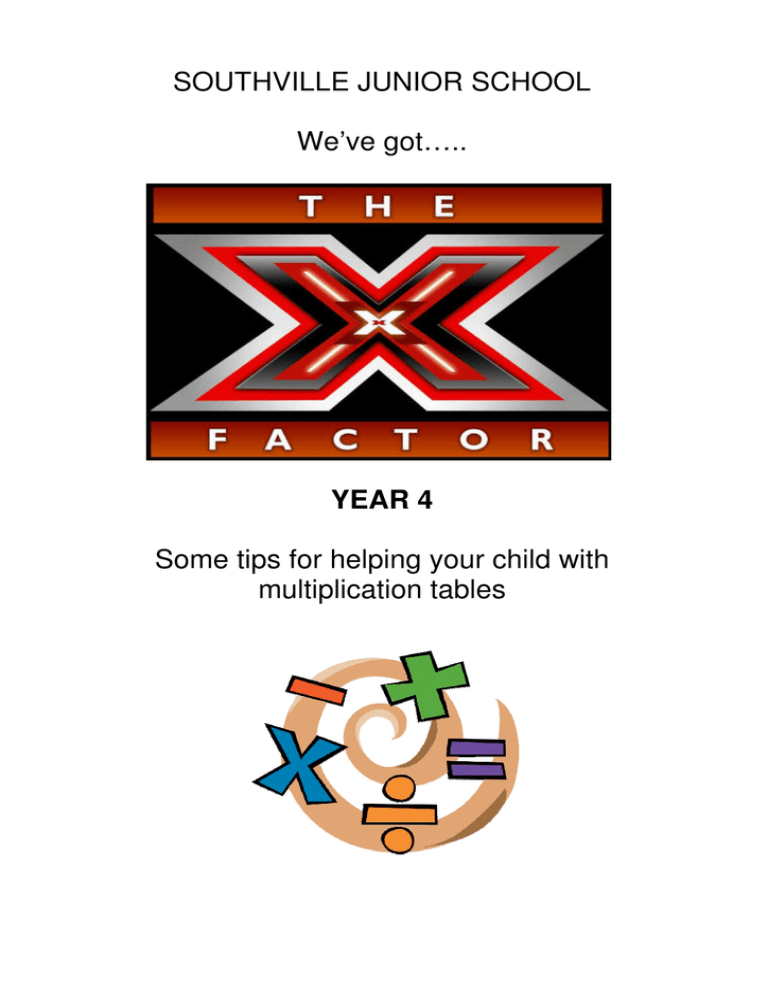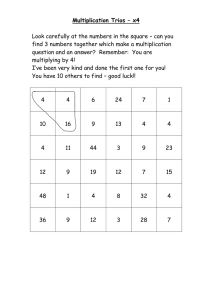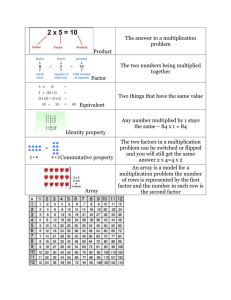SOUTHVILLE JUNIOR SCHOOL We`ve got….. YEAR 4 Some tips for
advertisement

SOUTHVILLE JUNIOR SCHOOL We’ve got….. YEAR 4 Some tips for helping your child with multiplication tables Our Targets Your child is working on one of the targets below. Their target is highlighted. YEAR 4 End of year expectation: Derive and recall multiplication facts up to 10 × 10, the corresponding division facts and multiples of numbers to 10 up to the tenth multiple. Mrs Tait and Miss Clarke Must I recall multiplication facts for the 2, 5 and 10 times-tables. Should I can recall all multiplication facts for the 2, 3, 4, 5 and 10 times-tables and I can recognise multiples of 2, 5 and 10. Could I can recall all the multiplication facts up to 10 × 10 and the division facts for the 2, 3, 5 and 10 times tables. Mrs Buchannan Must I can recall all the multiplication facts up to 10 × 10 and the division facts for the 2, 3, 5 and 10 times tables. Should I can quickly recall the multiplication and division facts up to 10 × 10 and use them to multiply pairs of multiples of 10 and 100. Could I can quickly recall all the multiplication and division facts up to 10 × 10 and use the knowledge of place value to find multiplication facts involving decimals e.g. 0.8 x 5 Websites Below are some websites that have games and activities linked to times tables. Why not try some of them out together? http://www.teachingideas.co.uk/maths/contents07multiplicationdivision.htm http://www.bbc.co.uk/skillswise/numbers/wholenumbers/multiplication/timest ables/game.shtml http://www.bbc.co.uk/schools/ks1bitesize/numeracy/multiplication/index.sht ml http://www.woodlands-junior.kent.sch.uk/maths/timestable/interactive.htm http://www.familylearning.org.uk/multiplication_games.html NOTES FOR PARENTS / CARERS Children need lots of practice in multiplication tables so that they are able to quickly recall the facts to help them with their maths at school. They should be able to answer e.g. ‘What is 6 multiplied by 3?’ as quickly as they can answer ‘What is your name?’ Check that your child can: • • Use some of the mathematical words for multiplication. These include: multiply, times, multiplied by, product (the result when 2 numbers are multiplied together e.g. the product of 5 and 8 is 40), multiple of (e.g. 10 is a multiple of 2). Children should also learn the division facts that go with multiplication facts - give multiplication facts quickly and work out division facts to go with them e.g. 4 x 6 = 24, so 24 ÷ 6 = ? Questions to ask your child: • • • • • What is 5 multiplied by 7? What is the product of 8 and 4? Can you tell me a multiple of 6 that’s more than 24? Is 16 a multiple of 3? How did you decide? Write down the multiples of 3. What patterns do you notice? FUN ACTIVITIES TO DO AT HOME Tables Practise the 3x, 4x and 5x tables. Say them forwards and backwards. Ask your child questions like: What are five threes? 7 times 3? What is 15 divided by 5? How many threes in 21? Dicey division You each need a piece of paper. Each of you should choose five numbers from the list below and write them on your paper. 5 • • • 6 8 9 12 15 20 30 40 50 Take turns to roll a dice. If the number you roll divides exactly into one of your numbers, then cross it out, e.g. you roll a 4, it goes into 8, cross out 8. If you roll a 1, miss that go. If you roll a 6 have an extra go. The first to cross out all five of their numbers wins. All the sixes Time your child while he / she does one or more of these. • • • • Count in sixes to 60. Count back in sixes from 60 to zero. Start with 4. Count on in sixes to 70. Start with 69. Count back in sixes to 3. Next week, try to beat the record. ACTIVITIES USING THE MULTIPLICATION GRID Please note, that you should work with the times tables that your child is learning. This may not be the whole grid! x 1 2 3 4 5 6 7 8 9 10 1 1 2 3 4 5 6 7 8 9 10 2 2 4 6 8 10 12 14 16 18 20 3 3 6 9 12 15 18 21 24 27 30 4 4 8 12 16 20 24 28 32 36 40 5 5 10 15 20 25 30 35 40 45 50 6 6 12 18 24 30 36 42 48 54 60 7 7 14 21 28 35 42 49 56 63 70 8 8 16 24 32 40 48 56 64 72 80 9 9 18 27 36 45 54 63 72 81 90 10 10 20 30 40 50 60 70 80 90 100 Go through e.g. x2 table. Use this to work out x4 table by doubling. Also look at links between x5 and x10 tables (halving / doubling). Count through a table together. Write the pattern in the table and explore e.g. in the 3 times table the units digit is ODD, EVEN, ODD, EVEN etc. Play games e.g. bingo with one table or more! Play ‘buy one, get 3 free’ – If I know that 4 x 3 = 12, then I also know 3 x 4 = 12, 12 ÷ 4 = 3 and 12 ÷ 3 = 4. Pick a fact and challenge your child to write the other 3 facts. Encourage your child to cross out the facts they already know e.g. multiplication by 1 and 10. They should then identify the facts they don’t know and focus on learning these. They could cross out the facts as they learn them.


